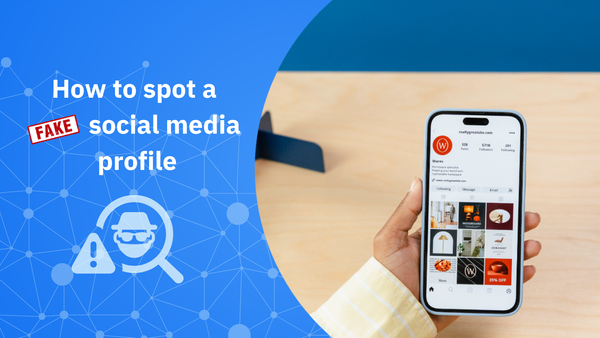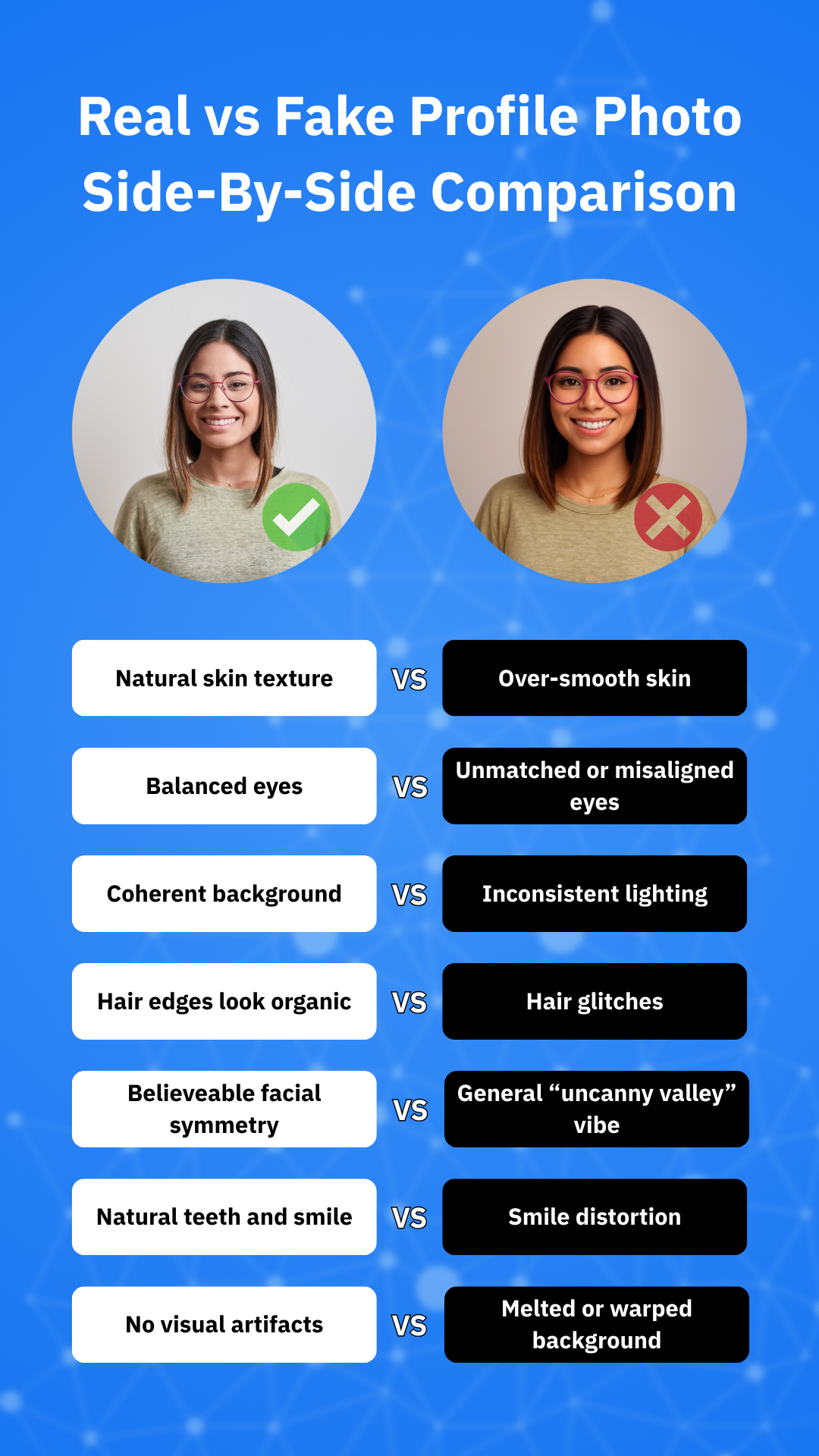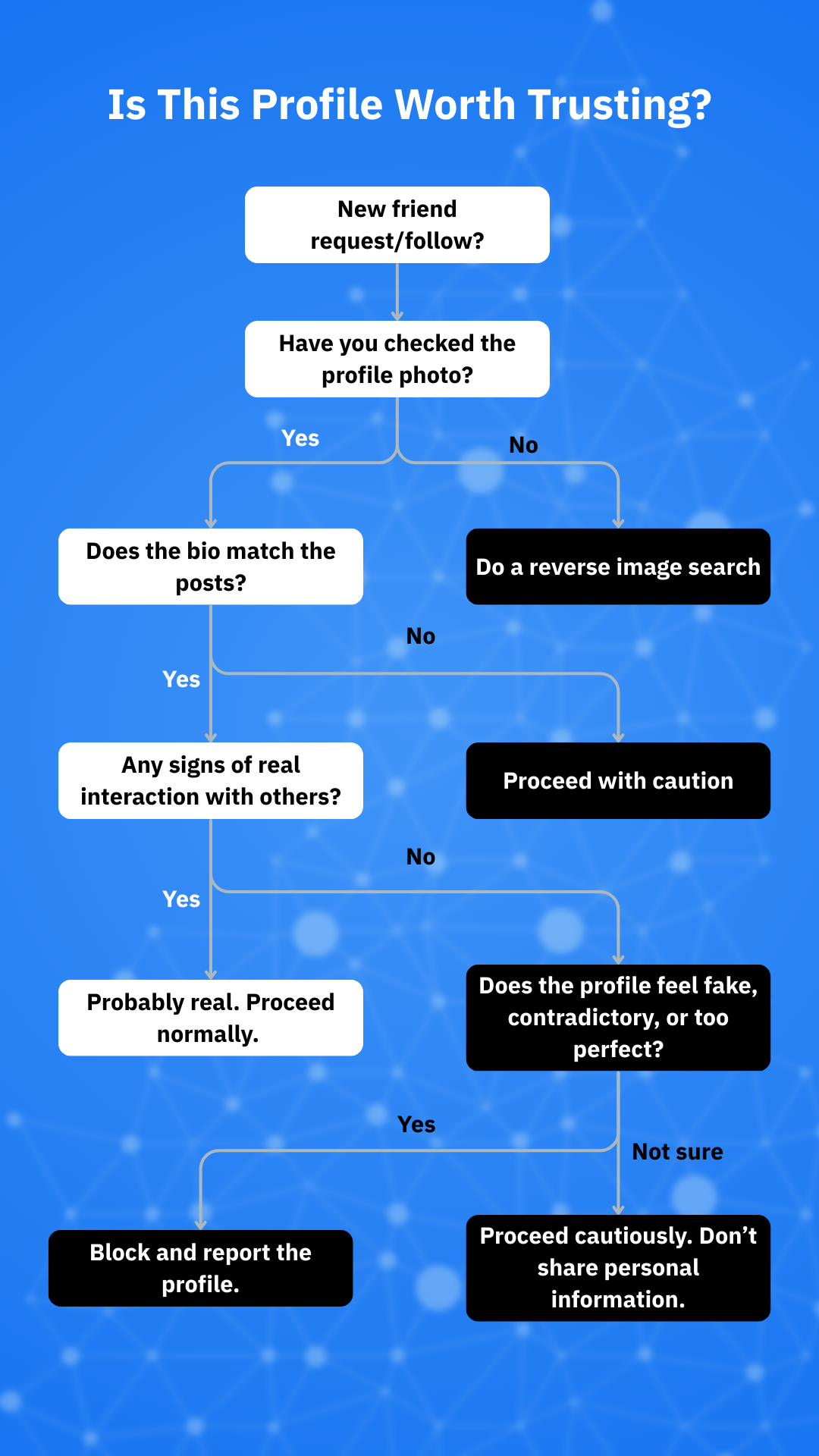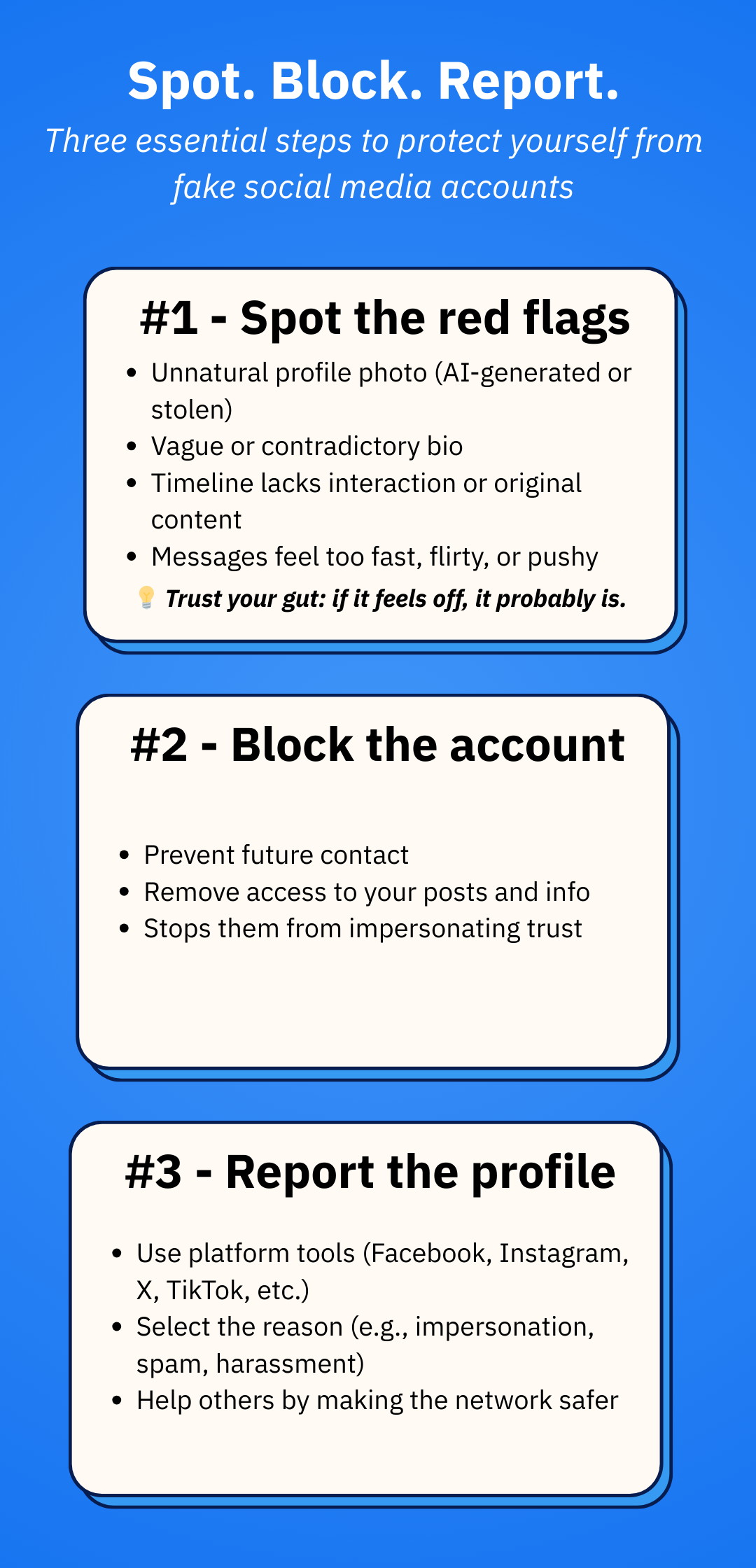How to Spot a Fake Social Media Profile

A seemingly friendly follow or message can quickly lead you into dangerous territory. Here’s how to tell who’s real and who’s not.
Why fake profiles are a real threat
Digital intimacy is perhaps the best way to describe our relationship with our online lives. We connect, befriend, and even fall in love with people we’ve never even met in person. While it sounds like a digital utopia on paper, the reality couldn’t be further from idyllic; online threats, like fake media profiles, have quickly grown into an epidemic.
Many such profiles are crafted with disturbing precision, as their puppeteers aim to wield them for manipulation, deception, and even theft. These masks take many forms, often cloaking fraudsters impersonating businesses, bot farms pushing political narratives, and scammers running romance cons.
While platforms like Facebook, Instagram, TikTok and X have ramped up their detection systems, the responsibility still falls on everyday users to recognize red flags. Let’s walk through how you can spot a fake social media profile and protect yourself before any damage is done.
The allure of perfection
The first thing most people notice about a profile is the photo. This is exactly what most scammers count on – fake accounts often use profile photos that seem too good to be true. Whether it’s flawless lighting, professional-looking headshots, or model-tier appearances, threat actors frequently use such photos for fake accounts.
Sometimes, perpetrators steal images from other profiles. Other times, they use AI to generate them. Either way, a fake profile picture usually stands out.
- Stolen profile pictures tend to have a lower resolution than the original. Social media platforms heavily compress photos to reduce storage and allow for faster loading times. Sometimes, a scammer may steal the profile picture of another fake account, perpetuating clarity loss.
- AI-generated profile photos can be tricky, as they are usually high-quality. However, they do have that “uncanny valley” feel to them, like something seems off but you can’t quite put your finger on it. Check for inconsistencies, like asymmetrical eyes, weird reflections in the eyes (or none at all), inconsistent lighting, backgrounds that don’t quite make sense, or blurry earrings.
A quick reverse image search using Google Images or TinEye can help determine whether a photo is used elsewhere on the web. It won’t do much for AI profile photos, though.

Empty words or contradictory details
After the photo, the next most-viewed part of a profile is the bio. A quick glance at a profile’s bio or description can reveal a lot to a keen eye. Some fake profiles adopt a minimalist approach, writing things like “living life to the fullest” or simply dropping an emoji, which could complicate things. Others overcompensate, packing bios with fake jobs, international locations and suspiciously generic interests.
Often, there’s a disconnect between what’s claimed and what’s posted. A person claiming to be a freelance photographer in Paris may have zero original photos, or their tagged locations suggest they’re halfway across the world. Fake profiles tend to crumble under scrutiny because they lack the organic complexity of real human lives. If details don’t quite connect, you’re probably dealing with a fake.
This is especially common in business impersonation scams, where fraudsters copy a logo and name but leave contact details blank or suspiciously redirect links. A little digging could uncover the inconsistencies.
A timeline devoid of stories
Genuine social media accounts often tell a story, whether it’s photos from a birthday party, public event attendance, or friends interacting. Fake accounts, on the other hand, tend to have timelines that either feel lifeless or curated. You might see a few reposted memes, scattered quotes, or content that was all posted within a short window of time.
There’s rarely any engagement on the posts, minimal comments (if any), and no one seems to tag them anywhere. Sometimes, all the content appears to be reposted from other creators. In more advanced scams, there might be a handful of original-looking posts, but they still feel hollow, missing that natural sense of being part of a real person’s life.

Messaging feels off
A fake profile isn’t inherently dangerous when it’s inactive, but things can go south fast when they start messaging people. One of the most important things to keep an eye on is the tone and speed of communication. Fake profiles often initiate contact quickly, jumping into private messages right after connecting. However, that’s not a foolproof way to detect a scam, as some fake accounts intentionally lurk for a while before establishing contact.
The conversation might start friendly, even charming, but it can escalate fast. Within a few exchanges, the scammer may start asking personal questions, trying to build emotional rapport, or even telling stories of hardship. Some of them could even ask you for apparently benign favors, like voting for them in a competition.
Some will ask for favors, money, or gift cards under the guise of emergencies, while others might lure users into clicking suspicious links or downloading attachments. If you’re dealing with a supposed friend or romantic interest who won’t video call or always has an excuse to avoid face-to-face interaction, that’s a red flag.
Keep in mind that scammers rely on speed; the faster they can earn your trust, the less time you have to think critically. If something feels even slightly rushed, take a step back and reassess the situation.
Engagement that doesn’t add up
Numbers can lie. Fake profiles might boast thousands of followers, yet not a single meaningful interaction on their posts. In some cases, their entire following list consists of blank profiles or users with names in other alphabets and no content. Keep in mind that it’s not unheard of for scammers to set up entire bot account networks, following and interacting with each other to create a sense of legitimacy.
Conversely, they might have an unusually high following-to-follower ratio, where they follow hundreds of people, hoping someone will follow them back. These bot-like patterns are common in fake accounts used to inflate visibility and send spam at scale.
Even in professional-looking profiles, engagement matters. Real people reply to comments, get tagged in stories, and have some back-and-forth with others. If the account feels like a monologue in an echo chamber, that should tell you something.
Verification is your friend
When in doubt, verify. Reverse image search tools are a great first step. On platforms like Instagram or X, check if the account is verified, especially if they claim to be someone notable or affiliated with a business. For phone numbers and emails, services like NumLookup or Social Catfish can provide quick context.
But even if the profile looks right, don’t ignore your instincts. If something feels off, it probably is. Scammers have become more adept at crafting real-looking personas, but they still tend to stumble on authenticity. They forget how real people behave over time, not to mention that setting up a “verified” account is now easier than ever.
Dedicated software like Bitdefender’s Scamio can be your trusted ally in identifying scams. Paste a text snippet, upload a screenshot, share a link, or even drop in a QR code and let Scamio work its magic. Using AI, natural language processing, and a robust threat database, Scamio can analyze the content in seconds and deliver a clear verdict on its perceived legitimacy.
What to do when you spot a fake social media account
If you suspect a social media account is fake, don’t engage, and don’t confront or try to “trap” the person behind it. If they contacted you first and it’s obviously a scam, report it to the platform using their built-in tools and cease communication. Facebook, Instagram, TikTok and X all offer reporting mechanisms for impersonation, scam and abusive behavior.
However, keep in mind that most of these platforms have switched to AI-driven reporting mechanisms. This can be frustrating; sometimes reporting questionable content or fake accounts can seem like hitting a brick wall; the systems may tell you that they detected nothing wrong. If that happens, block the account and try to tell others of your suspicions.
If the fake account is impersonating someone you know, or a business, inform the real party so they can act as well.

Conclusion
Not every friend request or follower is a threat; following that mindset would severely undermine the purpose of social media platforms. However, those that do pose a danger can deal serious damage. Recognizing a fake social media profile can help you protect your data, but also your identity, your time, your emotions, and sometimes even your finances.
Trust is a wonderful thing online, but it should be earned, not freely given. The next time you get a message from someone new, take a moment to look closely. Don’t be cynical, be smart.
Frequently asked questions about fake social media profiles
How to identify a fake social media profile
The account’s activity is one of the best indicators of its legitimacy. A low number of posts, lack of interaction, the absence of a profile picture, a questionable bio, or even a large number of bogus followers could mean you’re dealing with a fake account.
How do you know if the person you are chatting with is real?
Scammers often assume the identity of others or pose as representatives of legitimate businesses. Use reverse image search on their profile pictures and posts, and double-check with the business, if possible. Keep in mind that scammers often instill a sense of urgency and may have strange requests, such as clicking on links, sending them money, or telling them private details about yourself.
What are the red flags for catfish?
Catfishing scammers often build accounts that seem too good to be true, using stolen or AI-generated model photos as their profile pictures and writing enticing bios. Most of the time, they refuse video calls or meetings in person, as that could blow their cover.
tags
Author
Vlad's love for technology and writing created rich soil for his interest in cybersecurity to sprout into a full-on passion. Before becoming a Security Analyst, he covered tech and security topics.
View all postsRight now Top posts
How Do You Manage Your Passwords? We Ask Netizens
December 18, 2025
Cybercriminals Use Fake Leonardo DiCaprio Film Torrent to Spread Agent Tesla Malware
December 11, 2025
FOLLOW US ON SOCIAL MEDIA
You might also like
Bookmarks









